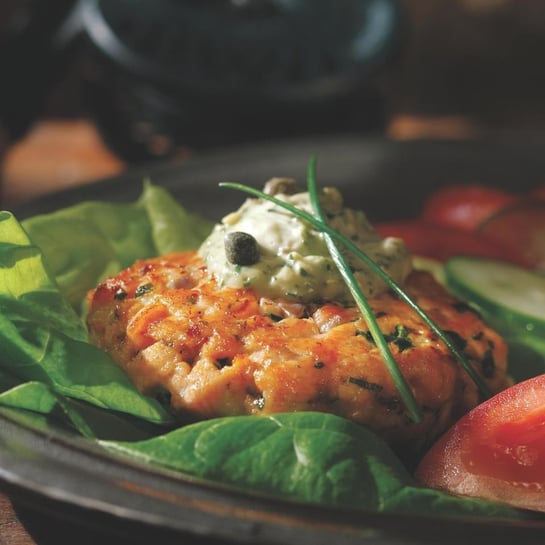Recipe By: John Ash from EatingWell.com
In this easy salmon burger recipe, ditch the bun and serve the burger over a bed of salad greens topped with a creamy green goddess dressing. The secret to this perfect salmon burger? Handling the fish delicately, seasoning lightly and not overcooking the salmon.Ingredients:
1 pound salmon fillet, preferably wild Pacific, skinned (see tip below)2 tablespoons finely chopped red onion or scallion2 tablespoons chopped fresh cilantro½ teaspoon finely chopped peeled fresh ginger¼ teaspoon kosher or sea salt, plus a pinch, divided⅛ teaspoon freshly ground pepper, plus more to taste3 tablespoons low-fat mayonnaise1 tablespoon reduced-fat sour cream1 anchovy fillet, rinsed and finely chopped2 teaspoons finely chopped fresh chives1 teaspoon finely chopped fresh parsley1 teaspoon capers, rinsed and finely chopped½ teaspoon freshly grated lemon zest½ teaspoon fresh lemon juice1 tablespoon extra-virgin olive oil or canola oil

This Salmon Burger with Green Goddess Sauce by EatingWell.com is a delicious and healthy alternative to a grilled hamburger.
Directions:
1. With a large chef's knife, chop salmon using quick, even, straight-up-and-down motions (do not rock the knife or the fish will turn mushy) until you have a mass of roughly ¼-inch pieces. Transfer to a large bowl; gently stir in onion (or scallion), cilantro, ginger, ¼ teaspoon salt and ⅛ teaspoon pepper (do not overmix). Divide the mixture into 4 patties, about 1 inch thick. Chill in the refrigerator for at least 20 minutes (or up to 2 hours).
2. Mix mayonnaise, sour cream, anchovy, chives, parsley, capers, lemon zest, lemon juice, pinch of salt and pepper in a small bowl.
3. Heat oil in a large nonstick skillet over medium heat. Add the burgers and cook until browned on both sides and just cooked through, 4 to 6 minutes total. Serve the burgers with the sauce.
Make Ahead Tip: Prepare salmon mixture (Step 1), cover and refrigerate for up to 2 hours. Cover and refrigerate the sauce (Step 2) for up to 3 days.
Tip: Wild-caught salmon from the Pacific (Alaska and Washington) are more sustainably fished and have a larger, more stable population. To skin a salmon fillet, place the fillet on a clean cutting board, skin side down. Starting at the tail end, slip the blade of a long, sharp knife between the fish flesh and the skin, holding the skin down firmly with your other hand. Gently push the blade along at a 30° angle, separating the fillet from the skin without cutting through either.

